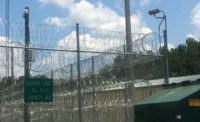
Close-up detail is provided from this luxury suite in the Staples Center in Los Angeles by a network video surveillance camera.
The Staples Center in Los Angeles has been busy most nights of the year since it opened in 1999. It is the home to five professional sports teams, as well as events ranging from rock concerts to political conventions. The facility has more than 120 luxury suites that offer a unique way to catch all the action.
One luxury suite owner decided to get closer to the action on the court and in the celebrity-packed crowd by hiring the Dotworkz Group, San Diego, a provider of IP-based video security camera systems, to install a network video camera outside the suite. With the system, viewers may be able to see a play being diagrammed in a team huddle or have a close-up look at celebrities in their courtside seats.
William Ferris, president of Dotworkz, sees the potential for systems such as this to become widespread and is positioning Dotworkz to capitalize on the use of security cameras for non-security purposes.
“It’s very important that we don’t lose sight of the fact that there are other industries out there that can benefit from the camera technology that we’ve been providing,” Ferris notes. “There is a lot going on in a sports arena, and this gives them a different perspective of the action.”

The Canon VB-C50iR camera features a 26X Canon optical zoom lens, a 12X digital zoom and a 340K effective pixel CCD imager that delivers 640-by-480-pixel resolution video.
“A main advantage that the network video camera technology brings is its ability to interface with the clients without causing confusion or frustration,” Ferris explains. “The idea is to give them something that allows them to hopefully break down the barriers and say, ‘This is useful technology.’”
The camera features a 26X Canon optical zoom lens, a 12X digital zoom and a 340K effective pixel CCD imager that delivers 640-by-480-pixel resolution video. It also features a pan of +/-170 degrees and tilt of +10/-90 degrees, which is well-suited to its installation.
Canon’s WebView Livescope monitoring software, which comes with the camera, allows pan, tilt and zoom adjustments to be controlled remotely via the Internet. Users also can view and control multiple cameras on a single screen.
The low-light capability of the camera also was an advantage to its installation. Different parts of the arena have different levels of illumination, from the bright lights of a basketball game to the near darkness of a rock concert. The camera can perform in lighting conditions as low as 1 lux at 1/30 shutter speed.
The zoom lens was a deciding factor for Ferris. “If the image is grainy, then it makes the whole technology look like it doesn’t really work well,” he comments. “If the image is shaky or the zoom doesn’t work or it goes too quickly into the digital zoom, it gets pixilated and discounts the whole thing. But the camera has been great for the client.”
The client is planning to add two cameras in the luxury suite. Ferris has been equally pleased with the performance of the PTZ camera.
“We can’t and won’t design an unprofessional presentation for our clients,” he declares. “If it’s not 100 percent, we have not done our job. Our reputation is on the line. We’re not going to use a product that could cause questions between us and the client.”




